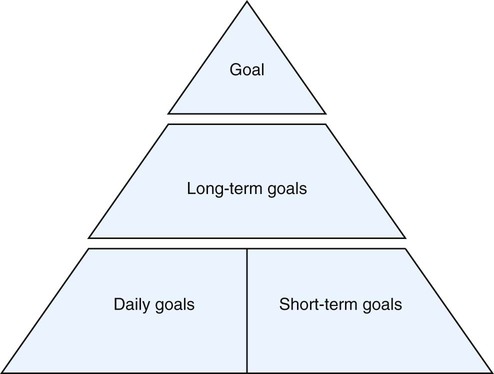Chapter 8 The key to goal achievement is to make it a persistent, methodical pursuit. The smartest way to stay on track in pursuing your goals is to keep a written record of where you’ve been, what you’ve done, and what you want to do next. Studies show that only 3% of Americans have written goals. So, logging your goals and the steps you will take to achieve them will put you far ahead of the game. The goal binder described in Box 8-2 outlines a system for keeping on track. “Hi, I’m Carly,” you say. “What can I do to help?” He shrugs and says, “I have no idea.”
Planning for Career Success
 Set goals and make their achievement a reality.
Set goals and make their achievement a reality.
 Explain the role of rules in the workplace and the effects they can have.
Explain the role of rules in the workplace and the effects they can have.
 Understand your responsibilities under HIPAA.
Understand your responsibilities under HIPAA.
 Create quality documentation that serves the patient indefinitely.
Create quality documentation that serves the patient indefinitely.
Setting Goals and Planning Actions
Learning Objectives for Setting Goals and Planning Actions
 Set precise, achievable, written goals.
Set precise, achievable, written goals.
 Map out action items to progress toward goals.
Map out action items to progress toward goals.
 Set reasonable deadlines for goals and action items.
Set reasonable deadlines for goals and action items.
 Intensely visualize the achievement of your goals.
Intensely visualize the achievement of your goals.
 Schedule time to accomplish action steps toward goals.
Schedule time to accomplish action steps toward goals.
How to Set Goals
Your Goal Binder
Following Rules and Regulations
Learning Objectives for Following Rules and Regulations
 Characterize the need for special rules in health care.
Characterize the need for special rules in health care.
 Know the difference between written and unwritten rules.
Know the difference between written and unwritten rules.
 Understand why people want rules and want to know what they are.
Understand why people want rules and want to know what they are.
 Suggest a positive attitude toward rules.
Suggest a positive attitude toward rules.
 Understand what it takes to know when an exception to a rule is needed.
Understand what it takes to know when an exception to a rule is needed.
Planning for Career Success
































